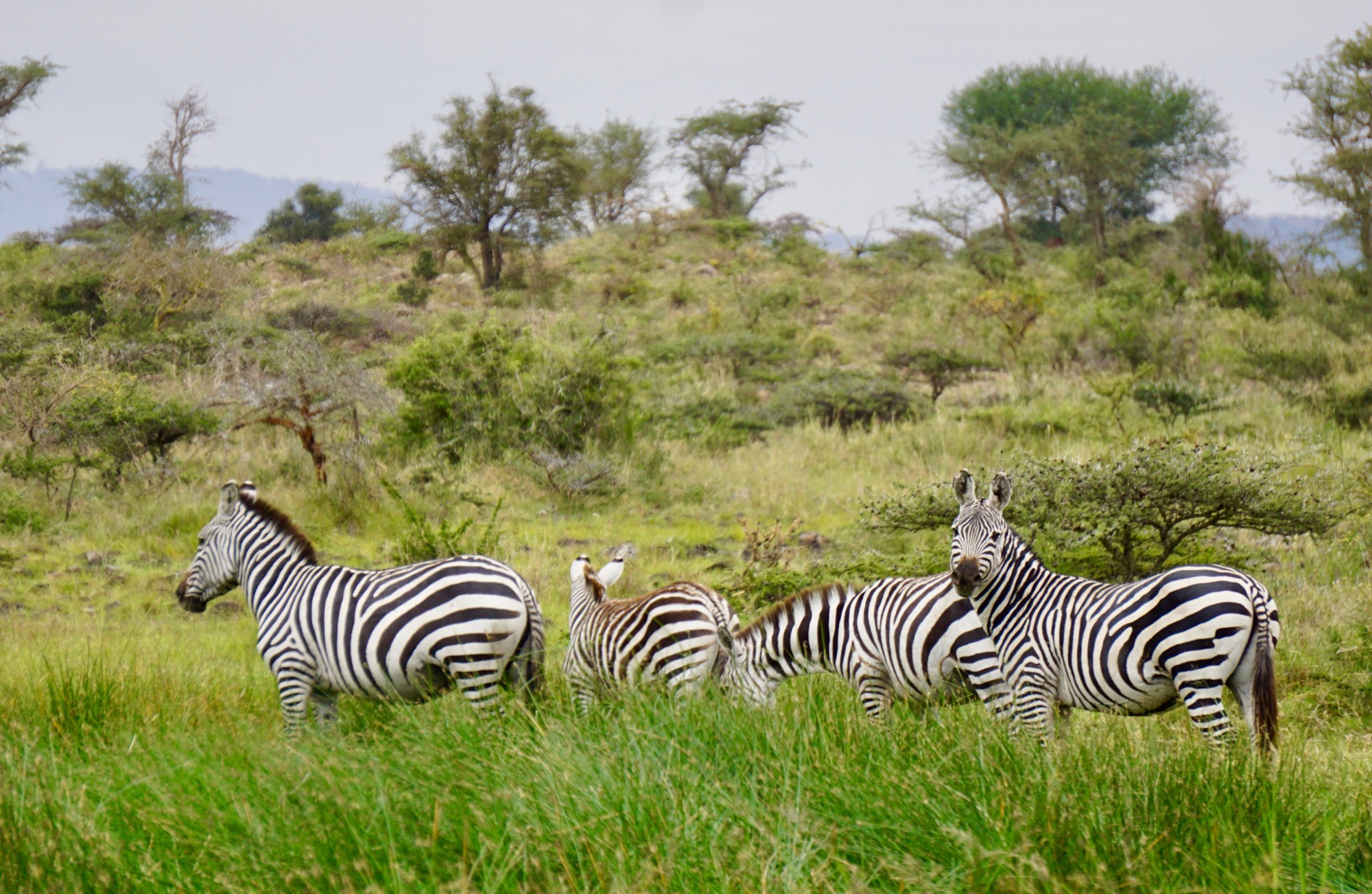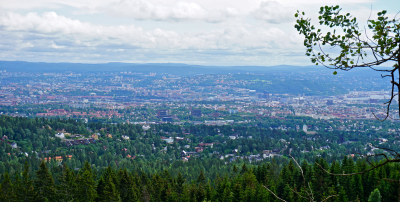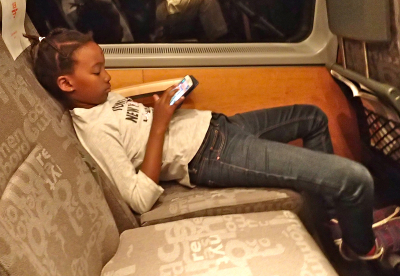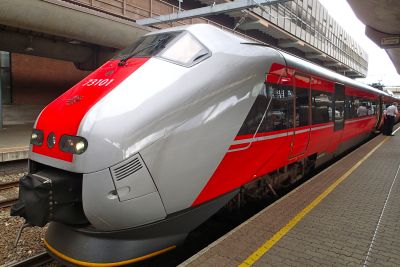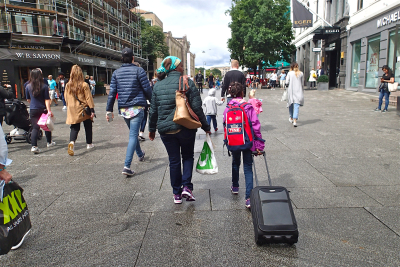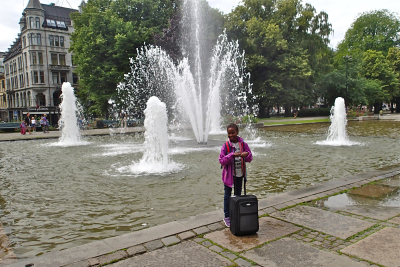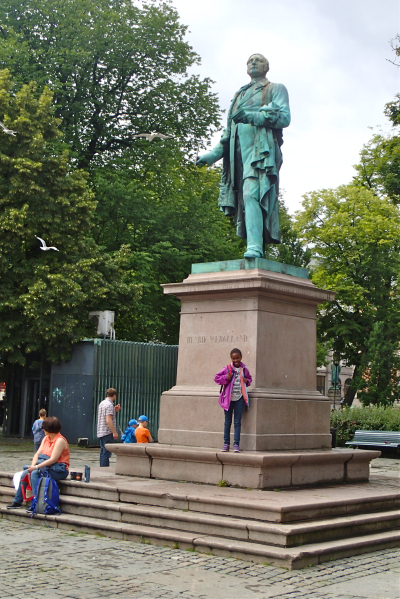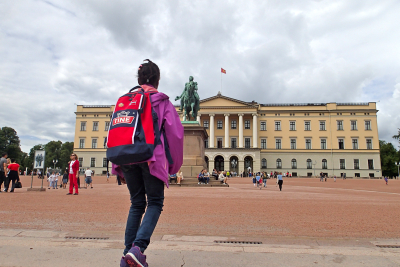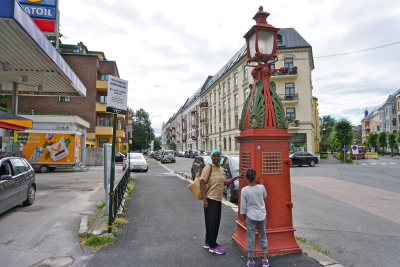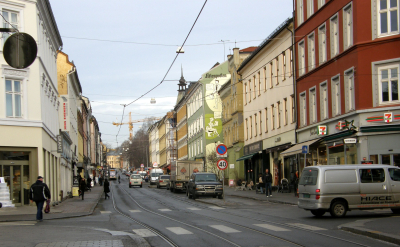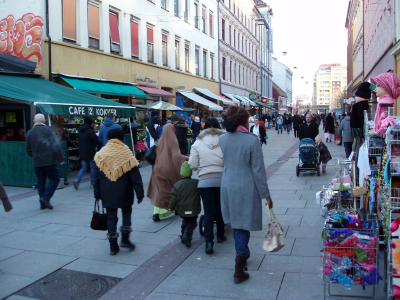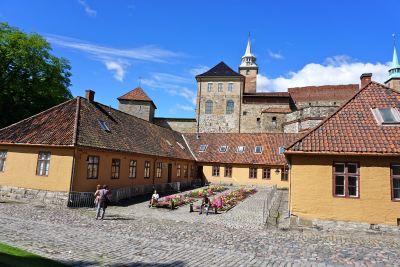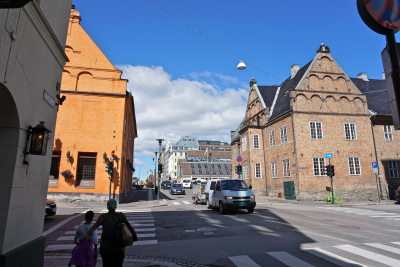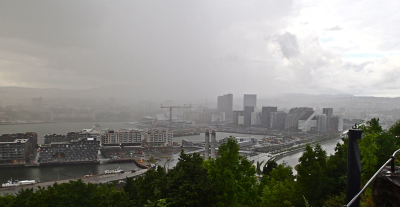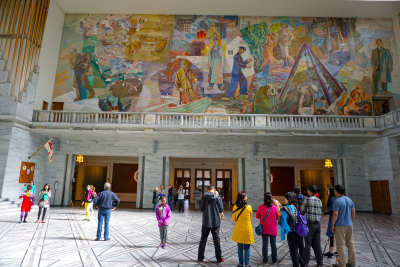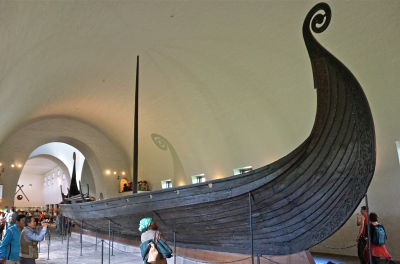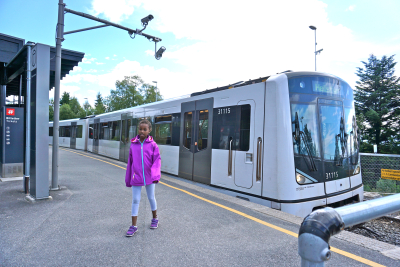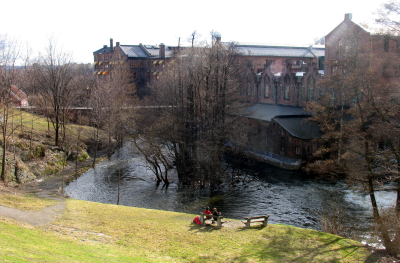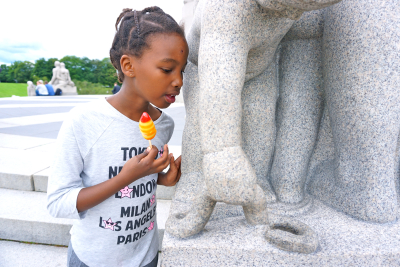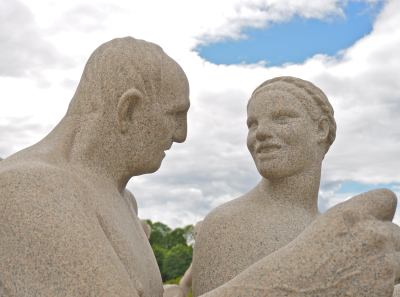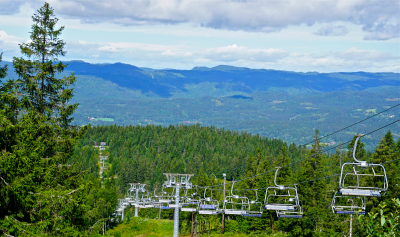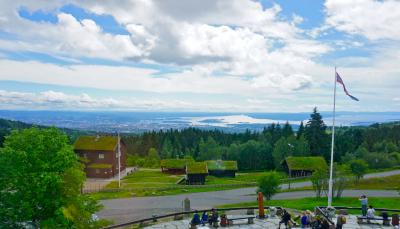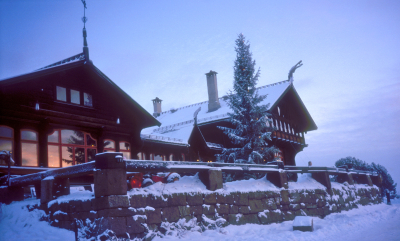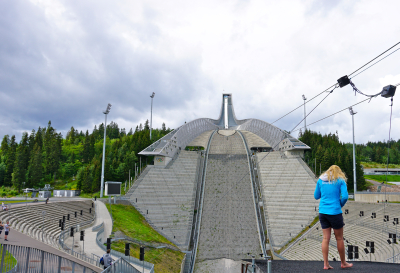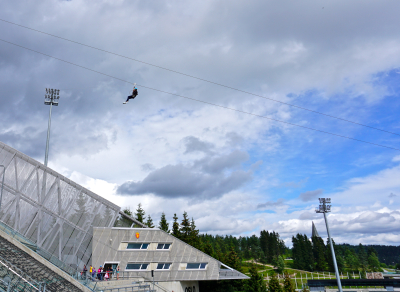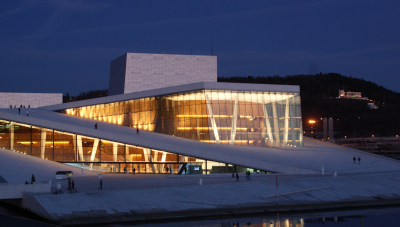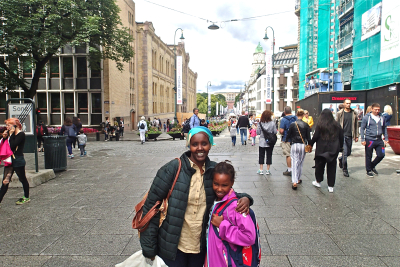A town you’ve been kid, grown up and been an adult in. Yet it is a city I have a love – hate relationship with – extremely so mixed. After 27 years of growing up – I never wanted to come back to stay, but feel free to visit, to go home again. But I do not really know the cause.
This time I would go with my two women to a visit the town. We should be tourists in my own city. Fatma had visited the city once before, Salmah had never been there, but she had been in another big city: Nairobi – several times. Oslo cannot be compared with Nairobi.
We decided to stay overnight at Kochs pensjonat, fine, simple, central and quite cheap. We also decided to take the train, dull enough, but far more interesting than just driving, using the bus – or flying (which was not in the picture at all). In any case, we arrived at Oslo a few minutes before route time – as usual.
My thought was that we took our stuff on our back – Salmah had undertaken to push the small suitcase all the way to the hotel – and walk to the Kochs. It would lead us up Karl Johann via the Castle and Castle Park to our “home” for the next two nights. No sooner said than done. And there was the presentation of the Oslo I had thought it would be. Lots of life. Tourists. People on the move etc. The weather was fine.
In “Spikersuppa” was a break – the fountain was fascinating. The statue of Wergeland was interesting because he also has a statue in Kristiansand – created by the young Gustav Vigeland. Equestrian statue of Karl Johann was interesting because he has given the name of school Salmah goes – Karl Johanns minne (memory) school.
The castle seemed nice, but small, said my women. I explained that when the castle was built, was Norway a poor country – the king could not afford to build a bigger castle. I always find that the castle has been the right size – it was at least large enough that the king could stay there with its over 100 rooms. The following day we were allowed to come in and see. Yes, the castle had certainly its beautiful rooms and atmosphere. A couple stories about royal peculiarities we were told meant that my faith in the Republic Norway were strengthened. Personally I think the Royal Garden is the nicest by the castle. Varied, green and nice – Today marked by 25 years of reign. Moreover, I think that Linstow was an accomplished architect – also in the design of the surrounding environment.
Today I see much more clearly the demonstration of the power of money inherent in many of the houses on the west side – just behind the castle – also where I grew up in Frogner. Many of the houses on Briskeby and Frogner are richly decorated. Although I had no sense of wealth when I grew up. I was not allowed to play in the yard because of the rats scurrying to and from. But from what I know, there was no pithouse there. You could find many of them in the east – even when I grew up. Being a boy at Bislett Stadium was much better in houses from the 1930s. The silly thing was that the kids were now adults, so here was no children. It was thankfully more kids nearby.
We traveled by tram through a typical East End district – Grünerløkka. Although facades is simpler here, I would not say that it is poverty that characterizes the area. This was the working class district – it is not the case today. It’s not as exciting to watch “Lillelord’s” journey to the eastern parts today as it was when Johan Borgen in his novel told about his secret tram rides around 1920. Eventually crawled tram up to Grefsen and Kjelsås. Here it was really different. It was a splendid view over the city and the houses had gardens. Statistics have allegedly difference between east and west in Oslo increased in recent years, but it is not as visible as it was.
This time we visited not the typical immigrant parts of Oslo. Maybe I should have taken them there? Fatma and I walked down from Tøyen and through Grønland a few years ago. It is a rather exotic and almost international travel, but I’ve never felt unsafe here.
Akershus castle has its own ambience where enthroned above Oslo harbor. We visited it one morning. It must have seemed terrifying once. The enemy could not have known that Christian IV made the castle into a palace for the king and his court with large open rooms to large festivities. It is used also for today, but perhaps more sporadic than in the old days. An interesting experience to walk around the halls, but also get a little peek into the dungeon. Good to be reminded that Akershus also was a place for slave labor – and a place where prisoners were executed during WW2. Many have problems with all the kings who have visited the castle – be it Håkon’s – Christian’s – and Fredrik’s and a solitary Hans.
From the castle I took them into the square shaped city, “kvadraturen”. Yes, Oslo also has its quadrature – filed by the same man who filed the Kvadraturen in Kristiansand 16 years later. But the houses here are much bigger and flashy and street environment becomes darker. But – occasionally – still has some houses from the 1600s survived – as a memory of something that has been. King moved the city behind Akershus fortress that would give the city protection. It managed the well to a certain degree.
In the oldest town – “Gamlebyen” (which until 1925 was called Oslo) – archeologists digs in the rubble and trying to find the oldest history of this city – as a national poet, Bjørnson, called at the time for “Tigerstaden” (the city of the tiger) – it will always mark them who came . (Because they discovered that the city was much older than first thought, celebrated city 900-year anniversary in 1950 and 1000 year anniversary in 2000.) We were way up and admired the view from the beautiful the Ekeberg restaurant – but the city was sadly shrouded in some rain showers. In June, I went to town past several of the church ruins found in the area. Hope it will be developed more parkland here where old industry of Kvaerner was cituated. It can be a real attractive area.
City Hall is always nice to visit. The hall is large and nice with its decorated walls from the ’30s and’ 40s. As City Hall was built in a slum area, it is not possible to see today. I can not remember the slums that were in this area – apart from the area by Vika. There snuck one past night. Already in the 60’s was the animal hospital Cheval torn – gave way to the insurance and banking – and a concert hall – which no one is happy with … But now it will be a great National Museum – we look forward to.
In the tough days, I followed my mother to and from Oslo V – Vestbanen (the west station) – that she would come to / from work in Sandvika. There have been many changes since then. Not least that Vestbanestasjonen has become a Nobel Prize Center ……
Actually, we now imagine a trip on the fjord. It become the ferry to Bygdøy and more history. For although it is a tourist magnet, it is both fascinating and interesting to see Viking ships – which today is more than 1000 years old. There is of course the Oseberg ship with its adornments that impresses most. Amazing what handicraft which is closed in this boat. Gokstadship is solid and beautiful and a far better sea boat, yet not too flashy. There is an incredible amount of history that is conveyed through these boats. Good thing they are well taken care of – let them be where they are ……
From Bygdøy and back to the city was the bus run on gas. Yes, Oslo goes ahead with cleaner public transport. Do not say that the bus trip was a pleasant experience. But Oslo has got a phenomenal T-bane (subway) system that brings people across town at 0 time at all. It’s departing nearly every minute. It could only dream about when I was a kid. But where the subway does not go, there may be a problem. Personally, I think the tram outperforms all other public transport. Pity the explotions of cars in the 60s were treated in such a bad way by politicians – who would lay down the tramsystem. Today I am excited about the new initiative on the tram will incur further. The trams strolling today should soon retire … .. (no one mentioned, no one forgotten).
What struck me this time is that Oslo is a green city. Perhaps it is greener in the east than in the west. In the east, there are many smaller green areas, such as Birkelunden.
In the west there are two large green areas Vigeland Park and Slottsparken (the Castle Park). We visited them both. My women was very astonished about all the nude men and women in the marvellous Vigeland park. And not only there.
The green thought was then formed through the construction of satellite towns around Oslo city senter. Closely “marka” – the forests – was very important for the design. This time we went not there. Although I have a penchant for Lambertseter – and Lake Østensjø.
We did a trip to Frognerseteren by T-bane (subway). It is many years since the old teak carriages climbed up here. It was a more charming trip. But Frognerseter was for many years my entrance to Nordmarka – especially in winter. It was also where I learned to ski in Tomm Murstad’s kindergarten. Øvreseter Pond still has something of the idyllic, but come on top is the full commercial operation of “Summerland” Winter Park Hill. But occasionally chairlifts – moving just because it blew – I could see the Promised Land – Nordmarka. The forests got me 3 distance marks on skis – a couple of local historian brands – and a major in geography. Oslo’s green lung is a wonderful wooded area that must never be destroyed ….
We did have lunch at Frognerseteren restaurant, a nice place with a splendid view.
Not far away is the famous ski jump, Holmenkollen, which we passed by. It is always impressive. People got the feeling of skijumping when they were alloved to go by e line all the way from the top of the tower to the end of the arena. I will never do that, but perhaps some young ones?
Oslo is the city where power is concentrated. It bears the stamp of. Oslo People have an unprecedented ability to see everything with an Oslo perspective. They forget that there are other perspectives as well. Oslo is a pretty town – but with their gloomy sides. Not all architecture is just beautiful. It looks more and more like the money power reigns – as for example in the Bjørvika area. Opera is no longer gaze caught it should be.
Oslo has a vast cultural offerings. It is the capital for the most part. Oslo is busy. Oslo is stress. Oslo is great. For me it is too big ……

